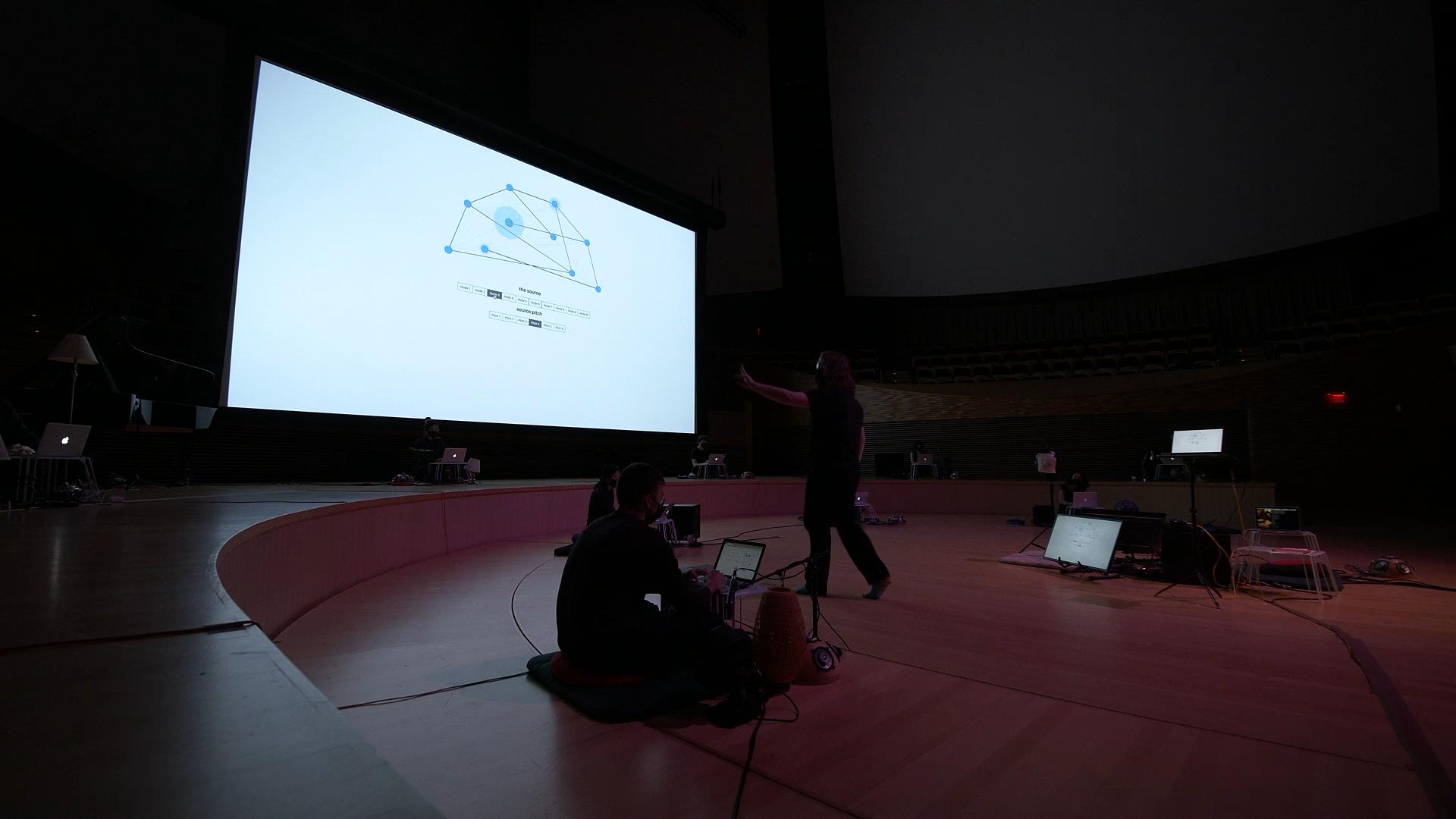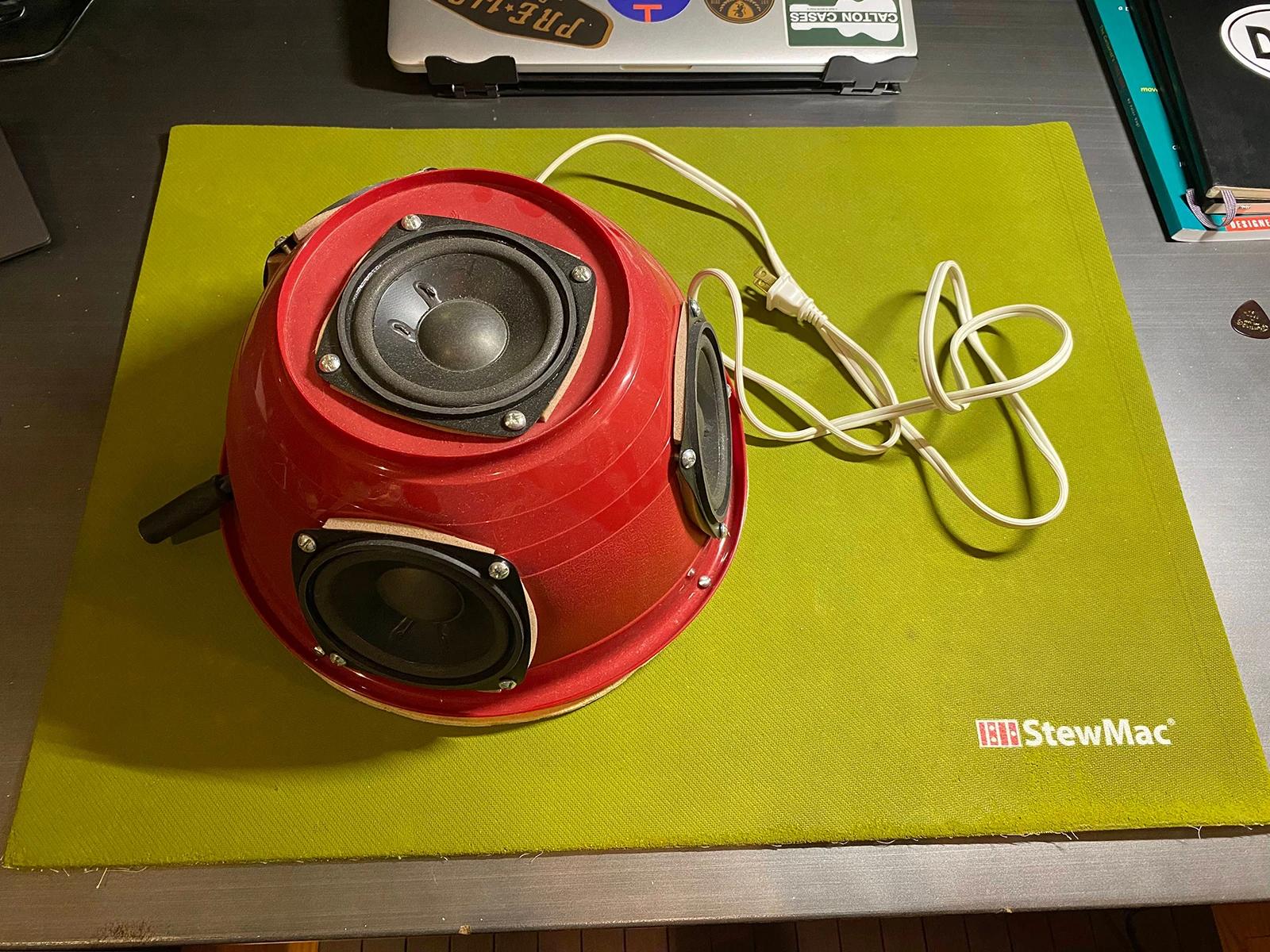
What I Learned in SLOrking School Is (or My Year of Designing Artfully)
By Sam Lowe
Partner, recycleReality
May 3, 2023
8 min read
In the spring of 2022, a journey that I had embarked on either 6 or 11 years prior - depending on how you count - reached its full-circle climax when I joined the first post-pandemic iteration of the Stanford Laptop Orchestra, also known as SLOrk. At its most basic level, SLOrk is an ensemble of student musician-programmers who perform at workstations consisting of Macbooks and hemispherical speaker arrays, utilizing digital instruments coded from scratch for each concert. From these fundamental ingredients emerged the culminating experience of my academic and creative endeavors to that point.
The length of the journey is up for debate because my time in SLOrk can be seen as a high water mark for either my musical pursuits, starting back in 7th grade, or my experience as a programmer, which began my freshman year at the University of North Carolina at Chapel Hill. However, I’ve never really considered these to be separate arcs - in fact, the reason I so quickly and deeply fell in love with computer science was because it felt like another expression of my creativity, just the same as music was. Fred Brooks, the founder of UNC’s CS department, said it orders of magnitude better than I ever could:
"The programmer, like the poet, works only slightly removed from pure thought-stuff. He builds his castles in the air, from air, creating by exertion of the imagination. Few media of creation are so flexible, so easy to polish and rework, so readily capable of realizing grand conceptual structures."

My newfound passion intermingled with the old from the start, my mind immediately turning to the potential for programming to evolve my artistic practice. Funnily enough, or perhaps not, web searches for music and computing very quickly lead one to Stanford’s Center for Computer Research and Acoustics (CCRMA) and the SLOrk performances they have been putting on since 2008. This fledgling fascination with the ensemble led me to my final project for my freshman seminar, Everyday Computing: a poor facsimile of a hemispherical speaker and a Wiimote-controlled Max synth patch.

Ultimately, I entered Stanford as a Master’s student in the Computer Science department, but my interest in CCRMA never waned. I took classes at the Knoll - CCRMA’s home in the former President’s mansion on campus - from the time I first matriculated, learning how to compose programmatically and design artfully.
An Exercise in Artful Design
Ge Wang, the founding director of SLOrk and the instructor with whom I took all my CCRMA courses - plus an independent study, to boot - teaches a paradigm he calls Artful Design, which you can learn all about in his book of the same name. At its most central level, Artful Design avows an approach to the construction of built artifacts - both physical and digital - that understands how design exists on a continuum between practicality and aesthetics. This methodology solves for human needs in a way that hews closer to artistic practice than pure engineering. By these standards, good design is that which understands its users’ abilities and desires while elevating the interaction beyond mere functionality. Great design strives for something higher: experiences that anchor you to a place or moment in time in a way that pulls back the veil on the broader human experience and our position in it. In a word, the sublime.
I received a full introduction to Artful Design when I enrolled in CCRMA’s Music 256a: Music, Computing, and Design. Over the course of the quarter, we took a deep dive into Ge’s textbook-graphic novel hybrid, while putting its lessons into practice in the form of audio visualizers, drum machines, sequencers, and synthesizers, all built with Unity and ChucK - Ge’s own music programming language.


I don’t think I would have classified any of my software work as “design” before that experience. In the world of technology, I had viewed design as the presentation layer - UI/UX as a siloed portion of the development process detached from my more functional work. Artful Design problematized this conception; when putting humans at the center of your design process, good design matters at every step along the way.
Ends-in-Themselves: An Aesthetics of Playfulness
With a newfound appreciation for the wide-ranging ramifications of design, I was ready to jump on the opportunity that had excited me so much at the start of undergrad: the Stanford Laptop Orchestra. During a typical SLOrk season, the ensemble works together to put on two performances: a small-scale “chamber music” concert early in the quarter and a full ensemble final concert. As a member of the 10-person ensemble, my responsibilities were simple - develop a piece for each.
An alternative conception of the dual importance of (and ever-present tension between) functionality and aesthetics in design is that of means-to-ends versus ends-in-themselves. Art and music are classic examples of ends-in-themselves, existing on the merit of pure aesthetics, but another central end-in-itself is that of play. The act of play - and the freedom inherent in such undirected, goal-less activity - is a universal human experience that has benefits at all stages of life, though we have a tendency to forget that fact as time goes on. It was in the spirit of playfulness that I settled on my first SLOrk piece, taking inspiration from friend and co-performer Marise Van Zyl’s love of all things cheerleading: Go Sporks!, a gamified cheer-off centered on an abstract drum machine.
I hope that the piece can be appreciated purely on its surface; being an engineer at heart, I think the technical details are fascinating, too. The software instrument here relies on a recurring piece of SLOrk technology: the GameTrak. Originally used for a golfing video game, the GameTrak is a USB-powered box consisting of two nylon tethers - one for each hand - and is a helpful tool for tracking hand positions in 3D space. Go Sporks! quantized this continual space into zones roughly corresponding to common cheerleading poses. The controllers trigger a sports-adjacent sample each time a performer’s arms move into a new combination of these zones, with the local area network serving to keep all players synchronized in time with one another. Within this basic system, the piece moves through three phases: the first, inspired by Guitar Hero, requires all performers to follow a predefined motion “script”, the second allows the respective “captains” to move freely while their teammates follow. and the final frees all performers to create rhythm as they see fit.
Blurred Lines in Digital Technology: Toys and Instruments
While play and creative pursuits are the basic examples of ends-in-themselves, they represent opposite ends of a spectrum typified by the tools used in each respective activity: toys and instruments (in the musical sense but also in the sense of paintbrushes as the instruments of art). Toys are low floor, low ceiling devices - easy to use but with limited possibilities. Instruments, on the other hand, are high floor, high ceiling tools - challenging to master but with near-endless potential.
The flexible, dynamic nature of the digital medium gives us the best of both worlds: low-floor, easily-accessible experiences that grow with you, unveiling new layers of complexity as you expand your mastery. This chameleonic ability was a key consideration in developing my second SLOrk piece for our final concert in Stanford’s Bing Concert Hall, In My Mind Are All the Tides. The piece at first appears to be the simple sound of dripping water spatialized across the concert stage. But over time, the performance begets a complex web of sonified relationships among the performers on the stage. By visualizing this interaction as it unfolds, we invite the audience to listen deeply to the evolution of the watery pulses and join us on a journey from the base element to a rich tapestry of sound.
Artful Apart from Art
At this point, you may be saying to yourself: “This is all well and good, Artful Design seems to have its place and its uses, but we are still firmly within the realm of ‘art’ when discussing this in the context of SLOrk, so does any of this really matter?” To which I would say: “Great question! And yes, absolutely.”
So why does Artful Design matter when you’re building a website or an AI system or a chair, for that matter? It matters because you’re never actually JUST building a website or an AI system or a chair. For one, every design exists in conversation with every other that has come before, in turn accepting, revising, or rejecting prevailing trends. More importantly, what we make ultimately makes us - some designs become fixtures in our lives and some of those fixtures help shape the social systems that govern us all. For evidence of this, you need not look any further than the consequences we are just starting to wrap our heads around regarding the seemingly simple design decisions behind our algorithmically-generated content feeds - see Olia Lialina’s excellent post FROM MY TO ME for an insightful exploration. The role of design in shaping society demands a respectful, thoughtful approach to every decision we, as designers, make.
There’s a lot more I want to say about how lessons from Artful Design and SLOrk intersect with our work here at recycleReality, but that’s what future posts are for, and you’ve already stuck with me this far. For now, I’ll leave you with two quick lessons for anyone who might find themselves as a laptop orchestra performer in the future.
Bonus: Two Quick Lessons from a Seasoned SLOrker
- Embrace anachronism. SLOrk is not an Agile, cloud-based dev shop. You WILL only get one 15-minute slot a week to rehearse and if your code breaks it breaks, which is what it must have felt like to program with punch cards. You WILL have to physically go to a rehearsal space to debug, a big shift back from this seamless remote era. The local area network WILL break, and 99% of the time you WILL NOT understand why.
- Don’t wear a tie dye shirt to hot pot that makes you look like well-marbled ribeye. You might get more ravenous glances in your direction than you can handle. Also, hot pot is delicious.

recycleReality is now Router.
recyclereality.net will remain archived if you'd like to explore our prior brand and portfolio.